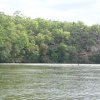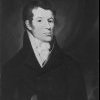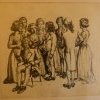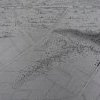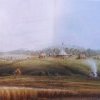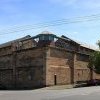Karskens describes this war as one of shifting alliances and complex negotiations. Their lives are already entangled, often they know each other by name. Karskens, The Colony, p. 445.
In January, Tedbury or Tjedboro, son of the famous Pemulwuy, arrives in Sydney, ‘armed with a bundle of spears’. He has been friendly with John Macarthur, who lives at Parramatta. Finding Macarthur safe at his town cottage, Tedbury exclaims, ‘Master they told me you were in gaol’.‘Well Tjedboro, what has brought you here with your spears?’ asks Macarthur, who was gaoled for a few hours the previous day. He replies, with eyes flashing, ‘To spear the Governor.’ (William Macarthur, A Few Memoranda Respecting the Aboriginal Natives (no date – c.1834), MS A4360:63, ML).
In March, Bennelong and Nanbarry each spear the Cow Pastures (Camden) leader Cogy in a revenge battle on the road between Prospect and Parramatta. For three weeks, Cogy walks about with a spear shaft sticking out of his body. (SG 17 March). In April: the spear is extracted. Despite his wound, Cogy is now well enough to take part in a punishment trial at the Hawkesbury River. Aboriginal people ‘from the interior of the mountains’ use tomahawks to kill two stockmen at John Macarthur’s farm at Camden. Armed settlers chase a group estimated at more than 300 Aboriginal people. In May, Aboriginal clans ‘composed of families well known about Prospect and Parramatta, with some strangers from the Cowpasturesare permitted to ‘sit down’ (camp) between Prospect and the Georges River. Orders are given that they should not be molested. (Government and General Order, 5 May 1805, HRNSW, Vol. V: 616.)
In July, two Aboriginal people, Nabbin and Major White, are reported killed at Richmond Hill. They are believed to have murdered Thomas Hodgkinson and John Wimbow late in 1799. Magistrates Samuel Marsden and Thomas Arndell give food and clothing to two Richmond Hill chiefs, Yaragowhy and Yaramandy [Yarramundi], and ask them to help put an end to the ‘mischiefs’. On 7 July, a 13-year-old Aboriginal girl is caught trying to set fire to the Hawkesbury River farm of Thomas Chaseland. It is discovered that the girl also burned down the house of Henry Lamb, whose family had brought her up. The next day, Judge Advocate Richard Atkins discloses the death by shooting of ‘Tal-lonn’, said to have murdered Macarthur’s stockmen. He says a party led by Obediah Ikins has killed ‘many of them’. Atkins gives his opinion that Aboriginal people cannot be brought before a criminal court. (Richard Atkins to Governor King, 8 July 1805, HRNSW, Vol.V: 654).A week later, Tedbury is released from gaol at the entreaty of the ‘friendly natives’ who helped to capture Musquito. In August: Musquito and Bulldog threaten to set Parramatta Gaol on fire and ‘destroy every white man within it’. Their attempt to escape is thwarted when a white prisoner informs a gaoler.
Shortly afterwards Governor King informs John Piper, commandant at Norfolk Island: ‘The Two Natives, Bull Dog and Musquito having been given up by the other Natives as principals in the late outrages are sent to Norfolk Island where they are to be kept, and if they can be brought to Labour will earn their Food—but as they must not be let to starve for want of Substance—they are to be victualled from the Stores.’(King to Piper, Sydney, New South Wales, 10 August 1805, Letter Book, 1797-1806, A2015: 495 ML; SG 11 August 1805)
In September, ‘Woglomigh’ (One-Eye) is shot dead and Branch Jack is shot and wounded while making his escape after an attack on a boat at the Hawkesbury River. Governor King orders that the settlers be required to assist each other in repelling visits and if any settler harbours natives he will be prosecuted for a breach of the Public Order. This is very unwelcome news for those who have tried hard to cultivate friendly relations with nearby clans. Karskens, The Colony, pp. 486-487. Video, ‘The history of the west’
